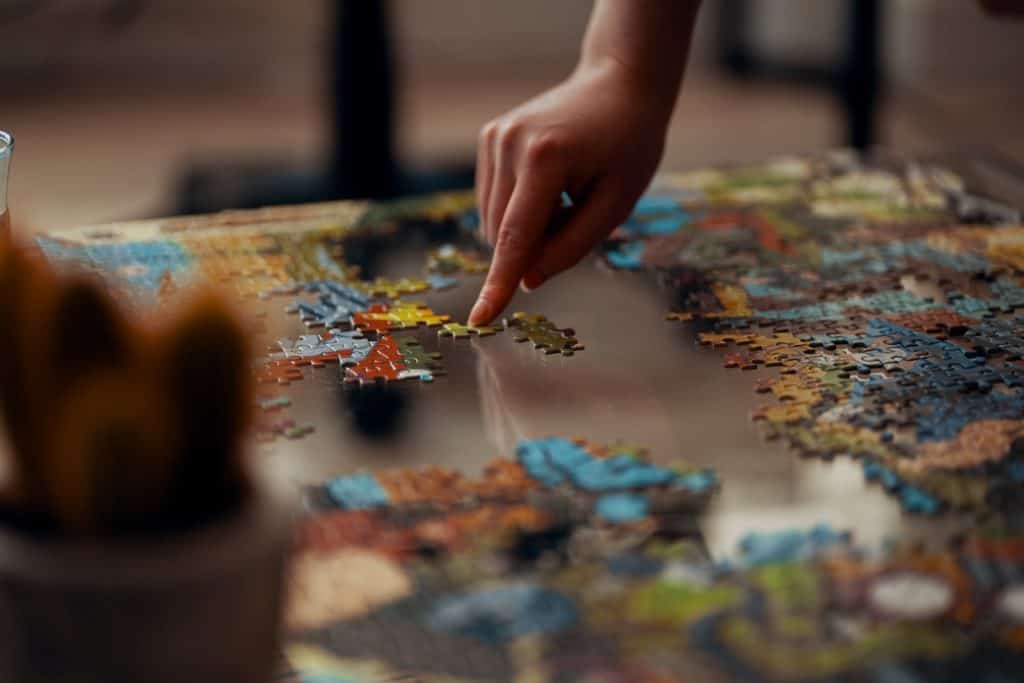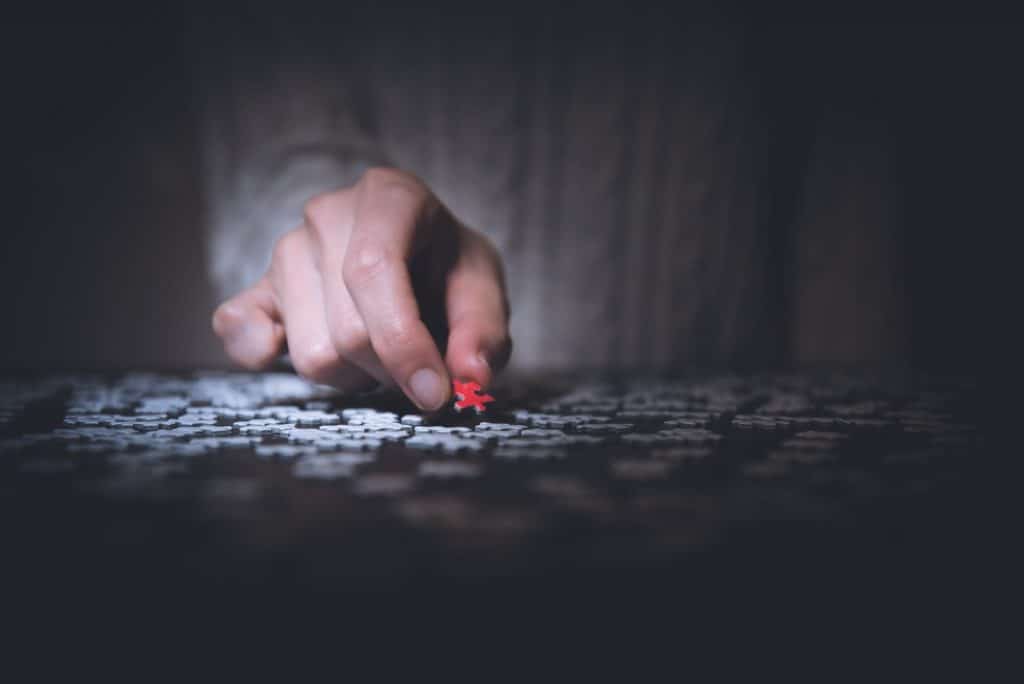Jigsaw puzzles have always been significant activity in my household. I find that they are a great way to relax and pass the time, while also exercising your brain. With old-style jigsaw puzzles making a comeback, we’ve seen an uptick in customers ordering custom puzzles. Occasionally, we get requests from customers asking for a jigsaw puzzle strategy to put together a challenging puzzle more quickly and effectively.

Jigsaw Puzzle Strategy
If you’re looking for a jigsaw puzzle strategy quickly and with as little frustration as possible, here are some jigsaw puzzle tips:
1. Choose a Work Area That Fits the Puzzle
The size of the jigsaw puzzle is always displayed on the box. However, it’s also essential to pick an area where you will not be constantly interrupted. While a kitchen table might seem like the ideal place to put together a puzzle, sometimes it’s just not feasible. Instead, look for a card table or another flat surface where you can place a puzzle mat or roll up puzzle mat that can be left undisturbed for a while.
2. Lighting Is the Key to Assemble Puzzles
The successful resolution of any jigsaw puzzle pieces requires clear imagery, which in turn demands the right kind of light. Floor lamps can provide some relief temporarily but may also give rise to shadows and strains on the back.
Many desk lamps are available on the market, though it is important to find one that can be turned and maneuvered without disturbing pieces that have already been placed. If opting for a desk lamp, I recommend choosing a wireless model as cords often become tangled or dislodged accidentally.
3. Turn All Puzzle Pieces Picture Side up
Although difficult jigsaw puzzle may be time-consuming, flipping all the pieces of the puzzle so that the picture is facing up will save you time in the long run. While you’re flipping them, you can sort the pieces into piles by edge and middle or color if you have trays or paper plates handy.
Put the pieces with matching colors and patterns together, which will also save time in the long run.
Sorting the edge pieces is a little quicker and more efficient when you sort through most, but not all, of them. The last few edge pieces will be easily visible as you begin to assemble the puzzle. If you want to avoid any extra time or mess, lift the puzzle pieces out by hand instead of dumping everything onto the table or floor.
This way you won’t have to deal with any manufacturing dust that might have been left on them too. When you’re finished sorting, just empty all the debris in the trash and use the box for storing your sorted pieces until you’re ready to work on it again.
4. Assembling the Border
Sort your standard jigsaw puzzles by border and center, then lay the photo of the completed puzzle on the table. Next to it, arrange all of the border puzzle piece in one area according to color, texture or pattern. Assemble the edges based on both your reference photo and the finished size of your puzzle–remember that round puzzles will have rounded edge pieces . And finally, keep in mind that corners can be difficult to locate!
By leaving the center of the frame empty, you will have less work to do when it comes time to assemble the border pieces.
5. Assembling the Center
All puzzle pieces have indents or protrusions that fit together like hooks or knobs. Now that you have sorted the pieces by color, texture, or shape, you can begin placing them together based on whether the indentations and protrusion will line up. Many times it’s obvious when they will (or won’t) line up.
Small sections are always the easiest way to go. You can work on one area without becoming overwhelmed or frustrated, and once you complete that section, it’s time to find its home within the framework of the puzzle. By doing this you’ll get a sense of accomplishment and be able to see your progress as you place each piece into its rightful spot.
To avoid getting frustrated, work on one area of the puzzle at a time. It’s helpful to start with a section that has some sort of pattern or text because it’ll be easier than working your way from the edge in. And if you ever feel stuck, just move onto another part of the puzzle!
6. Keep Working On It and Don’t Give Up
Puzzles come in all sorts of shapes, sizes, and difficulty levels. Sometimes it’s best to take a break from the puzzle and come back to it later with fresh eyes. Don’t get frustrated if you can’t finish the puzzle right away – this is quite common. The more you work on puzzles, the better you’ll become at them.
Oftentimes, looking at the problem from a new perspective or angle can help. Try walking around your dining room table, for example. Additionally, check for gaps or high/low points in the puzzle; these are usually indicative of a misplaced piece. Lastly, when all pieces are placed correctly, puzzles should be tight and flat on top.
Final Thoughts On Jigsaw Puzzle Strategy
Overall, the key to completing a jigsaw puzzle successfully is organization and patience. By flipping all pieces up, sorting them into piles, starting with the border, assembling small sections at a time, and not giving up, you’ll be able to conquer any puzzle thrown your way! Here are some great ideas on what to do with your finished jigsaw puzzles.

